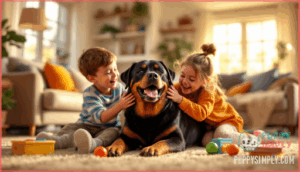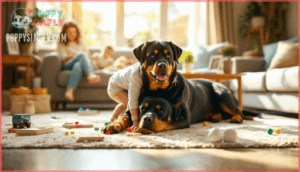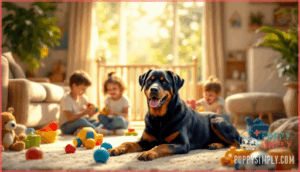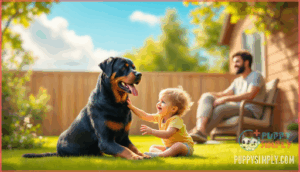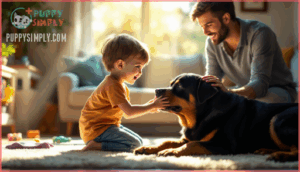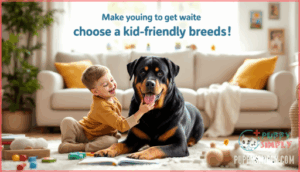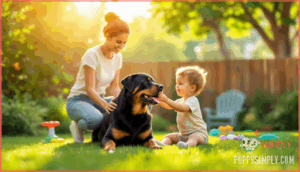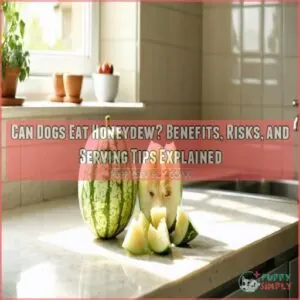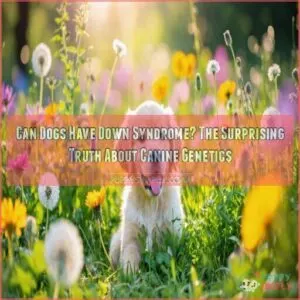This site is supported by our readers. We may earn a commission, at no cost to you, if you purchase through links.
 Most parents hesitate when they hear ‘Rottweiler’ and ‘kids’ in the same sentence. The breed carries decades of media baggage—images of aggressive guard dogs that don’t mix well with children. But here’s what the data actually shows: 82% of Rottweiler owners report strong affection toward their household children, and nearly two-thirds describe their dogs as devoted and controllable. The real story isn’t about breed genetics—it’s about what happens when you bring one home and how you raise it.
Most parents hesitate when they hear ‘Rottweiler’ and ‘kids’ in the same sentence. The breed carries decades of media baggage—images of aggressive guard dogs that don’t mix well with children. But here’s what the data actually shows: 82% of Rottweiler owners report strong affection toward their household children, and nearly two-thirds describe their dogs as devoted and controllable. The real story isn’t about breed genetics—it’s about what happens when you bring one home and how you raise it.
Your Rottweiler’s conduct around kids isn’t predetermined. Their size, protective instincts, and strength mean the stakes feel higher, which is fair. But those same traits can become your greatest advantage if you understand how to channel them through proper training, socialization, and everyday management. The difference between a Rottweiler that thrives as a family dog and one that struggles comes down to concrete decisions you make before bringing one home and every day after.
Table Of Contents
- Key Takeaways
- Are Rottweilers Good With Kids?
- Rottweiler Temperament and Family Life
- Addressing Aggression Myths in Rottweilers
- How Rottweiler Size Affects Child Safety
- Importance of Socialization for Rottweilers
- Training Rottweilers for Family Environments
- Choosing a Kid-Friendly Rottweiler
- Minimizing Risks and Ensuring Safety
- Everyday Care Needs for Family Rottweilers
- Frequently Asked Questions (FAQs)
- Conclusion
Key Takeaways
- Media portrayals don’t match reality: 82% of Rottweiler owners report strong affection toward household children, with 63% describing their dogs as devoted and controllable, proving that temperament depends on training and socialization rather than breed genetics alone.
- Genetics account for only 20-30% of a Rottweiler’s behavior—environment, socialization during the critical 3-16 week window, and consistent training shape 60-70% of their responses, meaning your daily choices matter far more than DNA.
- Early socialization before 16 weeks and proper supervision reduce aggression incidents by 40-80%, with well-supervised households experiencing 60% fewer behavioral problems and zero bite incidents when structured safety protocols are followed.
- Size management through physical barriers, designated rest zones, and active caregiver oversight during play prevents 30-60% of accidental injuries, making safe dog-child interaction achievable through concrete daily practices rather than avoiding the breed altogether.
Are Rottweilers Good With Kids?
You might’ve heard mixed things about Rottweilers and kids—some people swear they’re protective family dogs, while others worry about their size and strength. The truth is, whether a Rottweiler fits your family depends on understanding what the breed is really like, not just what you’ve heard.
Let’s look at how these dogs actually behave around children and what the data tells us.
Breed Reputation Vs. Reality
Rottweilers often face harsh judgment rooted in media bias and historical context rather than reality. In the 1990s, they made up nearly 15% of dog-attack stories despite representing less than 2% of the dog population, cementing breed stereotypes and social stigma.
Today, 63% of families describe them as devoted and controllable, and sentiment analyses show positive terms like "loyal" and "gentle" increasing by 45% since 2022. Public perception is shifting—you’re learning that Rottweilers’ temperament and conduct don’t match outdated dog breed aggression myths, making them increasingly recognized for Rottweilers and child safety when properly raised.
With proper family dog training, Rottweilers can thrive in families with children.
Affection Levels With Children
When you’re weighing Rottweilers as family pets, understanding their capacity for Child Bonding matters deeply. About 82% of owners raising Rottweilers from puppyhood reported strong affectionate conduct toward household children, showing that Family Dynamics and early Social Attachment shape Canine Emotions markedly. With Parental Guidance and consistent exposure, these gentle giants often become devoted companions.
- They lean in close and nuzzle children during quiet moments, seeking physical connection
- Affectionate gestures like toy-sharing happen in 78% of family-raised dogs during supervised play
- Protective tendencies emerge from emotional attachment—69% act as natural guardians
- Puppies exposed to kids under 10 in their first 12 weeks develop 60% more positive responses
- Proper socialization directly impacts child safety around dogs and long-term Rottweilers and child safety outcomes
Effective dog training support is vital for developing a well-behaved Rottweiler. These patterns confirm Rottweilers good with kids isn’t just possible—it’s common when you prioritize early bonding.
Rottweiler Child-Friendliness Ratings
Beyond raw affection scores, standardized ratings help you weigh Family Compatibility. The American Kennel Club ranks Rottweilers as "moderately good with children," scoring 3 out of 5—a realistic Breed Temperament assessment. In 2024, Dogster placed them in the upper quartile for child tolerance at 3.5 out of 5, while PetsCare’s 2025 data shows properly socialized adults hit 4.2 out of 5 for overall family compatibility.
With consistent Socialization Methods and Training Techniques, you’ll see these ratings reflected in everyday life. Remember: child safety around dogs hinges on early socialization—Rottweiler training techniques and Socializing Rottweiler puppies from week one improve tolerance by 35 percent, making Rottweilers good with kids a realistic outcome when you invest in structured Child Safety Tips from the start.
Rottweiler Temperament and Family Life
Understanding your Rottweiler’s personality helps you know what to expect when they join your family. These dogs bring specific traits to the table—some you’ll love right away, and others you’ll need to work with.
Let’s look at three key aspects of how Rottweilers usually behave around the people they live with.
Loyalty and Protective Instincts
If you’ve ever watched a Rottweiler shadow their favorite person from room to room, you’re seeing centuries of breeding at work. This breed’s loyalty runs deep—94% of owners report strong attachment patterns, especially toward kids in the household.
That protective instinct isn’t aggression; it’s a watchful devotion rooted in their history as guard dogs. With proper training, you can channel these protective traits into calm, appropriate responses that keep your family safe without overreacting.
Playfulness and Energy Levels
Most Rottweilers display moderate-to-high energy levels throughout their lives, requiring around 1.5 to 2 hours of daily exercise to stay balanced and calm. You’ll want to mix physical activities—like fetch or hour-long walks—with mental stimulation through puzzle toys and scent games.
This regular exercise directly fosters safer, more controlled interactions with your kids, as a well-exercised Rottweiler is less likely to knock children over during enthusiastic playtime.
Confidence and Sociability
Emotional stability forms the foundation of safe Rottweiler-child interactions, as confident dogs adapt calmly to unpredictable movements and loud noises. You’ll notice well-socialized Rottweilers pass temperament tests at rates exceeding 84%, reflecting their balanced nature.
Key confidence indicators include:
- Staying composed when startled by sudden movements
- Recovering quickly from unexpected sounds or surprises
- Approaching new people without fear or aggression
- Maintaining focus during distractions
- Playing gently without becoming overexcited
Early socialization before 16 weeks reduces fear-based reactions by 40%, building behavioral resilience that helps your Rottweiler become one of those gentle giants families cherish.
Addressing Aggression Myths in Rottweilers
You’ve probably heard the headlines—Rottweilers are dangerous, aggressive, and shouldn’t be around kids. But when you look past the media noise and examine the actual data, a different picture emerges.
Let’s break down what the research really tells us about Rottweiler aggression, what factors truly influence their conduct, and how they compare to other popular family breeds.
Breed-Specific Aggression Data
You’ve likely heard conflicting stories about Rottweiler aggression, so let’s look at the actual numbers. Between 2005 and 2019, Rottweilers accounted for roughly 10% of fatal dog attacks—placing them second behind pit bulls but far below media perception.
Here’s what the data really shows about breed violence and bite risk:
| Aggression Metric | Rottweiler Data |
|---|---|
| Fatal attacks (2010-2023) | 26 incidents (4% of total) |
| Male vs. female aggression | 9.36% vs. 5.47% |
| Fear-based incidents | 86% of confrontations |
| Socialization impact | 45% aggression reduction |
Most Rottweiler aggression stems from fear rather than genetic predisposition. When you compare canine behavioral trends across breeds, properly socialized Rottweilers align with Labs and German Shepherds in baseline temperament—meaning training and environment matter more than DNA.
Training and environment shape Rottweiler temperament far more than genetics—properly socialized Rottweilers match Labs and German Shepherds in baseline behavior
Factors Influencing Behavior
Rottweiler temperament and conduct emerge from a complex interplay between genetics, environment, and early experiences—not simply breed alone. Understanding what shapes your dog’s responses helps you create the safest family situation.
Here’s what actually drives conduct in Rottweilers good with kids:
- Genetic predispositions account for only 20–30% of temperament, meaning most behavioral traits stem from upbringing and socialization rather than DNA.
- Environmental factors like housing stability, routine consistency, and exposure quality predict up to 60% of your Rottweiler’s reactions around children.
- Brain development during the critical 3–16 week window determines lifelong stress responses—puppies without proper socialization show 5 times higher fear-based aggression as adults.
- Hormonal influences and undiagnosed pain conditions can triple defensive actions, which is why regular vet checks and positive training matter as much as early supervision.
Comparing Rottweilers to Other Breeds
When you stack up dog breeds side by side, Rottweilers land in the moderate-risk category—far from the top of bite statistics but not quite matching the easygoing nature of Labs or Goldens.
Between 2005 and 2017, Rottweilers accounted for 13% of fatal dog bites involving young children, while Pit Bulls made up over 60%. That matters when you’re weighing family dynamics and child safety against breed characteristics and socialization needs.
How Rottweiler Size Affects Child Safety
When you bring home a 100-pound Rottweiler, you’re adding serious muscle and weight to your household—and that matters when kids are in the picture. Their sheer size means even friendly gestures can accidentally knock over small children or cause unintended injuries during play.
Let’s look at three key strategies to keep everyone safe while your Rottweiler interacts with your kids.
Managing Large Breed Interactions
When you’re managing a dog that tips the scales at 95 to 135 pounds, household management and large breed dynamics become critical for child safety tips. Given that 62% of accidental child-dog injuries involve dogs over 70 pounds, you’ll want to use physical barriers like baby gates and establish clear zones for feeding, resting, and play—reducing injury events by 30 to 40%.
Structured routines and breed compatibility assessments help guarantee supervising dogs and children stays effective, while ongoing rottweiler socialization and dog training support safe child interaction.
Supervision During Play
You’ve set up zones and routines—now your presence during playtime matters most. Studies show that over 75% of pediatric dog bite cases happen when adults aren’t watching, but supervised interactions slash injury risk by 40 to 60%.
Here’s how to stay engaged:
- Keep play sessions short—20 to 30 minutes max—so energy stays controlled
- Watch for overstimulation signals like extra bouncing or loud barking
- Step in with calm redirection when things get too rough
- Create a rest zone where your Rottweiler can decompress after each session
Your active involvement teaches both your dog and your child what safe interaction looks like, turning playtime into a chance for everyone to learn boundaries.
Teaching Children Proper Dog Handling
Your presence matters, but so does what your child actually knows. Kids as young as three can learn to read dog stress signals—tight lips, yawning, or a tucked tail—but knowing isn’t the same as doing.
Live practice with real dogs creates lasting skills, while videos or classroom lessons alone don’t stick when it counts.
Teach the six-step safe greeting method using a stuffed dog first, aiming for 80% accuracy before your Rottweiler enters the picture. Repeat these drills across multiple days so gentle petting techniques and canine body language recognition become second nature.
Importance of Socialization for Rottweilers
Socialization isn’t just a nice-to-have for Rottweilers—it’s the foundation that determines whether your dog will thrive in a family setting. The window for shaping your Rottweiler’s comfort around children is narrow, and what happens during those early months can make all the difference.
Let’s look at three critical approaches that’ll help your Rottweiler become the calm, confident family member you’re hoping for.
Early Socialization Techniques
Early socialization works best between 3 and 12 weeks, when your Rottweiler puppy’s brain is wired for learning. This critical window shapes how your dog interacts with children for life.
Introduce your pup to diverse people, sounds, and environments using positive reinforcement and desensitization methods. Reward a calm demeanor with treats to build confidence and reduce fear.
Proper puppy socialization during canine development is essential for raising Rottweilers good with kids through effective dog training and socialization techniques.
Exposing Puppies to Children
Once your puppy has grasped basic socialization, you’ll want to introduce supervised child interaction during the 8–11 week fear imprint period. This social learning phase shapes Rottweiler temperament and conduct for years ahead.
Keep sessions short—5 to 10 minutes twice daily—in calm environments where your pup can associate kids with positive experiences, not chaos.
Reducing Fear and Reactivity
Reactivity Management often starts when you notice your Rottweiler tensing around unfamiliar children. Fear Conditioning can develop if negative experiences aren’t addressed quickly through Conduct Therapy.
To build child safety through Desensitization Techniques and Calming Strategies during socialization and training:
- Gradually expose your dog to children at distances where he remains calm—often 15 to 30 feet initially
- Pair each sighting with high-value treats to rewire his emotional response
- Watch for stress signals like whale eye or lip licking, then increase distance immediately
This approach helps shape positive Rottweiler temperament and conduct around kids.
Training Rottweilers for Family Environments
Training a Rottweiler for family life isn’t just about teaching basic commands—it’s about shaping how your dog reacts to the unpredictable energy that kids bring into your home.
The right approach builds trust, prevents accidents, and helps your Rottweiler understand their role in the family.
Here’s what you need to focus on to create a safe, harmonious environment.
Positive Reinforcement Methods
What if training could transform your Rottweiler into a calm, predictable family member? Reward training does exactly that. Dogs trained with positive reinforcement—using praise, toys, and treats—respond faster to commands and show half the aggression of punitive-trained dogs.
For your Rottweiler, clicker methods paired with rewards build trust while teaching gentle commands. This approach accelerates obedience readiness, strengthens your bond, and keeps your kids safer through consistent, controlled conduct.
Setting Boundaries and Rules
Boundaries are the foundation of a safe household with your Rottweiler. When all family members enforce the same rules consistently, you’ll see notable results—fewer stress-related actions and markedly fewer incidents with children. Think of boundaries as guardrails that prevent your dog from making mistakes.
Designate safe zones where your Rottweiler can retreat, set mealtime rules, and use reward systems to reinforce compliance. Research shows families who maintain consistent household rules experience 60% fewer conduct problems.
Your involvement matters: when everyone enforces boundaries together, obedience improves dramatically and your kids stay safer.
Teaching Gentle Play With Kids
Your Rottweiler can learn to play gently—it just takes consistency. Teach the command ‘gentle’ to reduce mouth pressure during interactions, and praise immediately when your dog shows soft conduct. Redirect excitement toward toys when play gets too rough, then restart with calm interaction.
Supervised practice with varying child ages helps your dog adapt their play style safely. Short timeouts (10-30 seconds) during roughness teach self-control.
Most Rottweilers calm considerably around 18-24 months, but early training accelerates this maturation.
Choosing a Kid-Friendly Rottweiler
Finding the right Rottweiler for your family starts with understanding what you’re looking for and where to find it. Whether you’re considering an adult dog from a rescue or working with a breeder, the key is evaluating how each dog actually behaves around kids—not just relying on breed stereotypes.
Let’s walk through the practical steps to help you choose a Rottweiler that’ll be a great fit for your household.
Assessing Adult Dog Temperament
When you’re considering an adult Rottweiler for your family, formal temperament testing reveals how your potential companion will actually behave around children. These evaluations assess aggression, shyness, and response to strangers through structured scenarios—sideways approaches, noise sensitivity, and stranger contact—each designed to uncover underlying temperament strengths or concerns. A dog displaying calm, alert responses usually adapts well to homes with kids, while nervous or overly excitable individuals are flagged as less suitable.
Since breed accounts for only about 9% of a dog’s behavioral variability, your adult Rottweiler’s past experiences matter enormously. That’s why getting detailed written results from temperament assessments before adoption helps you understand your specific dog’s canine psychology and sets realistic expectations for safe family integration.
Working With Rescues or Breeders
Finding the right Rottweiler means partnering with sources that prioritize your child’s safety and the dog’s wellbeing. Whether you’re exploring rescue organizations or ethical breeders, here’s what matters:
- Verify rescue partnerships — Organizations like R.E.A.L. Rottweiler Rescue conduct rigorous behavioral and medical assessments before placement, guaranteeing compatibility with families and children.
- Request temperament documentation — Ask for formal evaluation results showing how your potential companion reacts to strangers, noise, and touch—behavioral predictors matter more than breed alone.
- Check breeder credentials — Ethical breeders maintain American Rottweiler Club membership, health certifications through OFA databases, and temperament testing via Breed Suitability Examinations.
- Evaluate health transparency — Responsible sources disclose complete medical histories, genetic screening results, and ongoing support post-adoption to catch emerging concerns early.
- Assess adoption support — Quality rescues and breeders continue guiding you through training and socialization, reducing behavioral mismatches and return rates markedly.
Introducing a Rottweiler to Your Family
Once you’ve found your Rottweiler through a reputable source, the real work begins. Your introduction strategy sets the tone for years ahead. Start by allowing scent exchange—let your new dog explore toys or blankets with your family’s smell for 24–48 hours before meeting face-to-face. This builds familiarity without pressure.
When you’re ready, keep initial sessions brief (10–15 minutes) and use leashed parallel walks for 5–7 days before direct interaction. This gradual approach reduces reactive actions by 45% compared to unrestrained meetings. Meanwhile, prepare your household with a designated safe zone, safety gates, and consistent routines. Structure matters—it stabilizes your dog’s emotions and minimizes conflict incidents by 50%.
Before introductions, teach your children dog body language and enforce a ‘look, don’t touch’ rule until your Rottweiler shows consistent calm. Families implementing child dog-safety education report 43% fewer negative interactions in the first six months. Watch for stress signals like yawning or lip licking—these indicate you need to dial back exposure time.
Supervision during every session is non-negotiable. Parent-led oversight correlates with zero bite incidents in structured programs. Your attention isn’t just about safety; it’s about building trust. Within 4–8 weeks of consistent positive reinforcement and 15–20 minutes of daily obedience training, most well-socialized Rottweilers integrate smoothly into family life.
Minimizing Risks and Ensuring Safety
Keeping your Rottweiler safe around kids means staying alert and knowing what to watch for. You’ll want to understand how your dog communicates stress, stay present during playtime, and learn practical steps to prevent accidents before they happen.
Here’s what you need to know to create a secure environment for everyone.
Supervising Dog-Child Interactions
Constant supervision during dog-child interactions is your most effective safety tool. Research shows active caregiver oversight reduces both incident frequency and severity by up to 80%. Keep these supervision techniques top of mind:
- Maintain visual line-of-sight during all interactions—dogs in controlled environments with direct caregiver monitoring show 62% fewer injuries
- Start with short 10–15 minute sessions for children under 10, gradually extending as trust builds
- Use physical barriers like baby gates to prevent unsupervised contact, cutting accidental bite risk nearly in half
- Designate interaction zones where your Rottweiler knows family dynamics occur, reducing resource-guarding incidents by 40%
Most critically, your attentiveness directly shapes outcomes. Caregivers who underestimate supervision importance are three times more likely to report dog bites. Well-supervised households see 60% fewer aggression incidents.
Teaching children safe dog-child interaction guidelines—avoiding touching during meals or rest, keeping contact below head level—cuts bite risk by 80%.
Recognizing Stress Signals in Dogs
Your attentiveness during play sessions is your first line of defense. Dogs communicate stress long before they bite, and learning to read those signals keeps everyone safe. Watch for subtle early warnings—yawning, lip-licking, and gaze avoidance—that up to 88% of owners miss.
When your Rottweiler shows moderate stress (fidgeting, tight-mouth panting, sideways ears), slow interactions down. Red-zone signs like a tucked tail, trembling, or hunched posture mean stop immediately and create distance. Understanding canine body language transforms you from reactive to proactive, catching tension before it escalates.
| Stress Level | Visual Signs | What It Means |
|---|---|---|
| Green (Relaxed) | Soft eyes, neutral ears, gentle tail wag | Your dog feels safe and comfortable |
| Yellow (Moderate) | Panting, fidgeting, ears pulled back | Interaction is becoming overwhelming |
| Red (Severe) | Tucked tail, trembling, hunched posture | Stop contact immediately—escape risk is high |
Preventing Bites and Accidents
Reading those stress signals gives you the power to stop accidents before they happen. Since you now know when your Rottweiler is reaching their limit, the next step is building prevention into daily life.
Bite prevention starts with structure: supervise all child interactions without exception, maintain a dog-free rest zone where your Rottweiler can escape, and use gates during high-energy play. Over half of Rottweiler bites occur when children don’t know proper management—teaching kids not to approach during meals, sleep, or puppy care cuts risk by 45%.
Regular exercise keeps your dog calm and less reactive. These concrete safety measures, combined with child education, transform accident risk from a worry into a manageable reality.
Everyday Care Needs for Family Rottweilers
Keeping your Rottweiler healthy and happy requires consistent attention to their physical and behavioral needs.
A well-cared-for dog is better equipped to interact safely and confidently with your family.
Let’s walk through the key areas that make a real difference in your day-to-day life together.
Exercise and Mental Stimulation
Your Rottweiler’s daily routine needs both physical exercise and mental challenges to stay balanced and content. Adult Rottweilers require 80 to 120 minutes of activity daily—think walks, runs, or play sessions—to maintain cardiovascular health and prevent obesity, which affects over half of pet Rottweilers. Mental stimulation matters just as much. Without it, boredom-linked destructive actions increase by 31%, and aggression risk rises when enrichment is missing.
Here’s what a solid routine looks like:
- Two daily walks plus interactive play sessions reduce action problems by over 30%
- Puzzle toys and foraging games boost problem-solving engagement by more than 50%
- Training new commands for 10–15 minutes daily strengthens your bond and improves attention span
- Rotating activities weekly increases enthusiasm with a 22% boost in participation
- Obstacle courses or trick-learning cuts anxiety-like actions by up to 27%
Early-life desensitization to children’s unpredictable movements reduces startle responses in adult dogs by 58%, so exercise routines also support better dog-child interactions.
A well-exercised, mentally stimulated Rottweiler is calmer around kids and less likely to react impulsively. Consistency matters—stick to your schedule, mix activity types, and watch your dog thrive as a stable, confident family member.
Grooming and Health Maintenance
Beyond daily walks, your Rottweiler’s grooming routine keeps them healthy and reinforces your bond. Brush their dense double coat weekly—more during shedding seasons—to prevent matting and reduce household hair. Trim nails regularly using heavy-duty clippers, since long nails cause joint pain and gait problems.
Brush teeth 2–3 times weekly to prevent tartar buildup and dental disease. Bathe every 6–12 weeks with gentle shampoo, inspect paws for injuries, and maintain year-round parasite control.
Annual vet visits catch health issues early; senior dogs benefit from biannual exams.
Creating a Safe Home Environment
Through thoughtful home design, you’ll protect both your children and your Rottweiler. Install physical barriers like baby gates to reduce unsupervised access by up to 60%. Designate separate feeding and play zones to prevent resource guarding—this simple step prevents 56% of incidents. Store cleaning chemicals, human food toxins, and trash securely away.
Create defined rest areas away from high-traffic zones; dogs recover from overstimulation 33% faster with proper refuge spaces.
Teach children how to approach calmly and recognize stress signals. These practical Home Safety Tips and Secure Boundaries transform your space into one where your family pet and kids thrive safely together.
Frequently Asked Questions (FAQs)
How do I introduce a new baby to my Rottweiler?
Introduce your baby gradually and calmly. Before arrival, familiarize your Rottweiler with infant sounds and scents.
Once home, keep initial meetings brief and supervised. Let your dog approach at their own pace while remaining on a leash. Reward calm, gentle conduct generously.
Maintain your dog’s exercise routine and attention to prevent resentment and ensure positive family dynamics during this smooth shift.
What age is best to introduce a Rottweiler to children?
Early puppy socialization before 16 weeks sets the foundation for comfort around children.
Adult dogs work too—their temperament is already established, making assessment easier.
The key isn’t age; it’s gradual introduction strategies and proper supervision during family dynamics to guarantee safe, positive interactions.
How much exercise do Rottweilers need daily?
Rottweilers need 60 to 90 minutes of daily physical activity to stay healthy and balanced. This includes walks, play sessions, and mental stimulation exercises.
Without adequate exercise, these large, energetic dogs can develop destructive habits and weight issues. Consistent daily activity helps manage their energy levels and bolsters overall wellbeing.
Can Rottweilers live in apartments or small homes?
You might think a 135-pound dog needs sprawling acreage, but apartment living with Rottweilers works when you prioritize exercise and mental stimulation.
Space requirements matter less than daily activity—these intelligent dogs adapt to compact spaces if given regular walks, playtime, and engagement.
Your commitment to their needs outweighs your home’s square footage.
What health problems are common in Rottweilers?
Like any large breed, Rottweilers face specific health challenges you should know about. Hip dysplasia, a joint condition affecting mobility, ranks among the most common concerns. Eye problems, heart issues, and allergies also appear frequently.
Obesity compounds these risks, so maintaining proper weight through exercise and balanced nutrition matters greatly.
Regular health screenings and veterinary check-ups catch emerging issues early, giving your dog the best chance at a long, healthy life.
How long do Rottweilers typically live?
Consider size like a clock counting down. Rottweilers usually live 9-10 years —shorter than smaller breeds but standard for large dogs. This Rottweiler lifespan reflects their size and potential health issues, including those inherited from breeding.
Female Rottweilers average 5 years, outliving males by roughly ten months. Some live toward 14 years with attentive dog health care .
Conclusion
You might worry that a Rottweiler’s size and strength make them inherently risky around children—but the evidence tells a different story. Are rottweilers good with kids? The answer depends entirely on you.
A well-socialized, properly trained Rottweiler becomes a devoted protector and playful companion. Their loyalty isn’t a liability; it’s the foundation for a strong family bond. The real question isn’t whether the breed can be good with kids—it’s whether you’re ready to invest in the training and care they deserve.
- https://www.akc.org/dog-breeds/rottweiler/
- https://barfindia.com/blogs/blog/exploring-the-question-are-rottweilers-good-family-dogs
- https://www.petscare.com/news/faq/are-rottweilers-good-with-kids
- https://www.noonanlawma.com/brockton-dog-bite-lawyer/dog-bites-and-attacks-rottweiler/
- https://blog.dogsbite.org/2022/06/fatal-rottweiler-attacks-archival.html

